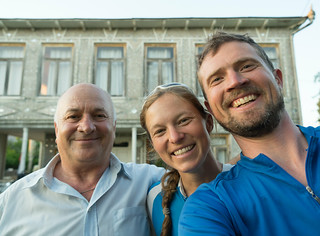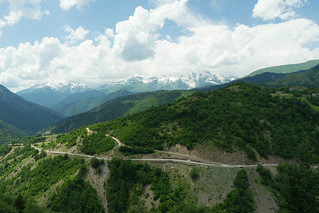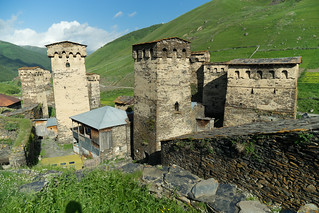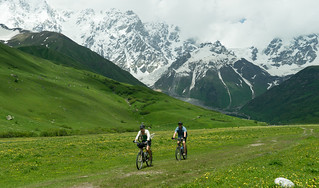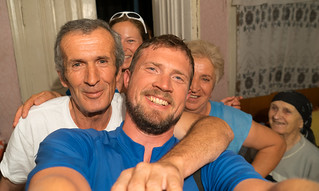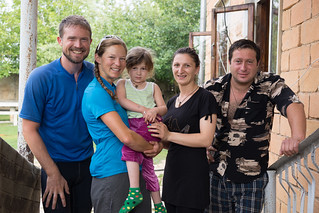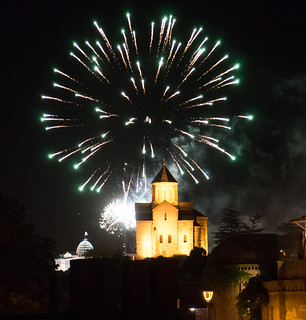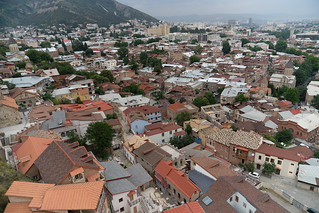After 6 weeks in Turkey, we approached the border with mixed emotions. We were already wistful about the call to prayer 5 times a day, endless invitations to drink cay, the delicious food, and striking scenery; we were also sad that we would no longer be able to use our hard-earned, if still rudimentary, Turkish language skills. At the same time, crossing an international border is a concrete ways to feel like we’re making forward progress, and we were excited to experience Georgia. After an easy border crossing, we biked along the coast to the Black Sea ‘resort’ town of Batumi, thinking we might stop at the beach for a few hours and then move on. As soon as we made it from the busy inland road to the pedestrian – and bicycle! – boulevard along the shore, we decided to stop for the day and spend the night there. No sooner had we made the decision then a sudden, urgent hissing sound came from David’s rear tire – the sidewall that had gotten cut in Southern Turkey and that David had reinforced with a piece from his goretex foot covers could hold no more – the tire was done, but we appreciated the convenient timing. He fixed it while Cilem and I set out to find a hostel. Walking through the city, I was struck by how European it looked – I felt like I was in a mini Lisbon with the large, statue-filled squares, balconies over back alleys, and grand public buildings.
We spent two nights in Batumi, splitting our time between the beach and making good use of the fast wifi in our hostel to wrap up the Turkey phase of the trip. Cilem befriended another cyclist, Flavien from France, and he joined us when we rode out of town the next day. We continued along the shore, hoping to visit Kholketi National Park to learn about how sea level rise threatens the wetlands there. However, their visitors’ center did not seem to be expecting visitors (the alarm went off when we opened the door), and the boats – which are the only way to visit the park – were not working. So we rode on, had lunch with Cilem and Flavien, and then bade them farewell – both were heading to Turkey, while we were going onward through Georgia. It was sad to say goodbye to Cilem – we had become good friends in the almost week we stayed at her house and during our time riding together. Hopefully she will make it to California someday so we can host her and take her bike touring. We then biked through peaceful lowland towns with quiet roads containing more cows than cars. As sunset approached, we saw that the area was too populated to sneak off the road and camp, so we decided to ask somebody if we could camp in their yard.
We stopped at a store and asked to fill the water bladder. The shop owner took us to his yard, conveniently right behind the store, and got us water from the well. The yard looked like a great place to pitch a tent, so we asked if we could camp using a handy recording that a Georgian guest at the hostel in Batumi had made for us. The shop owner, Yuri said yes, of course, and invited us in. We spent some time using google translate with their son, asking about climate change (he said that it rained more than it used to, and he thought it was because of the huge Enjuri Dam nearby). Yuri took us on a walk through his huge garden with his grandson Dmitri, picking cucumbers and proudly exclaiming ‘Natural, natural!’ Later we enjoyed the cucumbers along with garden-fresh tomatoes and parsley, homemade cheese, and… some beverages. It started innocently enough with a 2L bottle of beer Yuri brought down from the store. Then out came the chacha, homemade alcohol similar to Italian grappa. Next some homemade wine materialized, and finally a bottle of cognac. In Georgia, one doesn’t sip one’s drink – you wait for the person in charge to make a toast, and then down the whole thing in one go. Sometimes the men will link arms and drink a shot together. I felt a bit less pressure to drink than David did, although Yuri still looked at my half-full glass disapprovingly. Yuri’s brother, mother-in-law, and neighbor all joined as well. As the night unfolded Yuri got merrier and merrier, insisting on calling David “Johnny” and kissing our heads and slapping our backs affectionately saying da, da, da! It had become clear that we would not be camping, and eventually we were led upstairs to our bedroom for the night.
The next morning, after more ‘natural’ salad, bread, and coffee, we thanked our hosts and continued on. It was one of those deceptive roads that looks flat but isn’t, so you feel terribly sluggish as you plod along (though perhaps we were feeling the chacha as well). We passed more towns and their elaborate cemeteries, which consist of small fenced or walled areas holding headstones with the deceased’s photo engraved on them. Eventually we started climbing in earnest, and after leaving the towns behind, came upon the Inguri dam. It was impressive – 270m tall, holding back a rushing river that flows down from the glaciers in the Great Caucasus and producing 1.3 gigwatts – and accounting for a significant portion of Georgia’s electricity. The reservoir was long and deep, filling a narrow canyon that dropped steeply away from the road. We passed almost no signs of civilization – only the occasional beekeeper and roadside shrine to somebody who had died there (not hard to imagine with the steep cliff on one side of the road and questionable driving habits). I worried about finding water and food, and made David stop to sample some honey, which resulted in the purchase of a liter, meaning that honey featured in every meal on the way to Tbilisi. We also stopped when a family waved us over for some watermelon – the stop ended up including shots of undrinkably strong chacha and a roadside serenade from their smiling, guitar-playing daughter. Eventually the reservoir started tapering into the river, and we camped that night on a bank of soft silt left behind by a tributary.
The next morning we left our campsite and kept climbing. Up and up and up we rode, with the occasional downhill to erase our upward progress but help with forward movement. It was very pretty, and very hard. Snowcapped peaks started rising up behind the steep green mountains around us, and we kept going up. Our goal was Mestia, the main town of Upper Svaneti. Svaneti refers both to the region, high in the Great Caucasus, and the people, who speak a distinct language and have lived in the isolated valleys for millennia, avoiding many of the conquests that the rest of Georgia endured due to their remoteness. However, they haven’t been entirely safe over the centuries, and the region is known for tall stone towers where families would take shelter during invasions and blood feuds, which apparently were common until quite recently. We arrived in Mestia around 5:30, just in time to share a beer in the town square, where 2 cows grazed and play-fought around us.
We stayed at a guesthouse recommended by a group of Italian cycle tourists that we met in town, and the owner arranged for our bags to be taken to our next destination – Ushguli – in a van driving a group of tourists there the next morning. We wanted to drop weight for this leg of the journey because we knew it was unpaved most of the way, a rough uphill track to a tiny village near the highest mountain in Georgia. After handing all of our worldly possessions off to the driver the next morning, we started off. We were soon passed by a horde of Estonian cyclists and their Georgian guide. We played leapfrog with them all day, along with the Italians – the most cycle tourists we’ve seen this whole trip! It wasn’t nearly as hard as I expected, although only the first few kilometers were paved. We arrived in Ushguli around 4:00 and agreed that this was what we had come looking for in the Great Caucasus. Ushguli is a small collection of neighborhoods made up mostly of stone houses in varying condition, connected with narrow muddy paths and sprinkled everywhere the iconic stone towers. It sits partway up a valley created by the Shkhara glacier, with Shkhara Mountain glimmering behind it.
We decided to camp in the yard of the guesthouse where the driver had delivered our bags. The Estonian group was staying there, and their guide helped us out with information about the road ahead and translated questions about climate change so we could ask the family who ran the guesthouse. They are Svaneti natives and have lived in Ushguli for generations – the current owner’s parents ran a guesthouse during Soviet times, and his mother still lives there, helping his wife cook amazing food and charming the guests. They said that the Shkhara glacier had retreated in past years, and that winters are warmer now. The women said that this makes life easier, but the man said that overall the weather is less predictable, making it difficult for farmers to grow their crops.
We decided to spend two nights so we could visit the glacier, and it really felt like vacation. We left our bags at the guesthouse and biked up a dirt road through a valley lined with green meadows where the villagers’ cows, sheep, and goats were grazing. Every few minutes I’d look up and see Shkhara mountain looming closer, though its peak was covered in clouds. After about 6km the road turned into a narrow track, and we ditched the bikes in the bushes and continued on foot. After awhile we reached the toe of the glacier, covered in silt and small rocks which were occasionally released from the glacier’s hold and came rattling down its slope. We could see how the glacier had carved the valley, almost all the way down to the village, and how it had deposited sediment, from silt to gravel to boulders, as it moved downhill, leaving them in place as it retreated. We had lunch out of reach of the falling stones, hiked back down to our bikes, and enjoyed the downhill return journey like giddy children. We rode through streams, along meadows full of wildflowers, and stopped to take dozens of pictures. Our bikes held up well, though this whole leg of the journey would have been more comfortable with front shocks.
We left the next morning knowing we’d have about 10km of uphill on dirt to reach the pass, then another 60 or so of mostly downhill, still on dirt. It was more challenging than the route to Ushguli, but ultimately doable, and we were rewarded with great views all the way up. Descending from the pass, we saw another glacier, then followed a river through a dense green valley where we didn’t see another soul – except for one Polish man on a motorcycle, doing a loop through Svaneti in the opposite – and much more difficult – direction. We weren’t sure if we’d make it to our destination for the night because progress was so slow, but after passing through several small, fairly run-down looking villages in the lowlands, we were delighted to discover pavement for the last 10-20 km.
The next day brought us to Georgia’s second city of Kutaisi, which was the capital in the past and currently houses the parliament. We took an early evening break there for a beer and some Internet errands, then continued along the now-busy highway to look for a campsite. After several false starts, we turned off the highway and pedaled past a few homes and fields before stopping in front of a shop, where we deployed our handy recording to ask about camping. We were told we could camp behind the shop, but before we set up our tent a man appeared and struck up a conversation. Our Georgian never advanced beyond “hello” and “thank you,” and our Russian was even worse; however, we understood he was inviting us to his house, and soon two little girls showed up, one of whom – Mariam – spoke fairly good English and ended up being our translator for the night.
Our host, Giorgi, brought us to his house and introduced us to his family. Mariam’s father showed up, and when we asked about Internet (to use google translate), we were shepherded to Mariam’s house. When we arrived, the table was set – as if they’d been expecting us – and before long we were offered the most delicious cheese in Georgia, crepes, salad, and, of course, drinks. Mariyam’s father made several toasts, each of which required downing a shot of chacha or wine. At some point, Mariyam Skyped her brother Otto, a university student in Tbilisi, for high-level translation so we could ask about climate change. It turns out that Otto did a summer program in Amherst (David’s home town), has visited DC, and speaks perfect English. After several nights in guesthouses, it was great to stay with a family and make new friends. Mariam in particular charmed us – at nine years old, she had an impressive command of English and a lot of poise and confidence, serving as the translator for a room full of adults. Everybody was so warm and excited to have us there, something I have slowly gotten used to after our experiences in Turkey, but which still floors me every time. Otto put it nicely: “they are proud of their generosity, and happy to be able to host you.”
It took two more days to get to Tbilisi, mostly on a main highway that was fast, but tiring, since you can never relax even with a wide shoulder. We camped another night in a field, and visited the Stalin museum in Gori, his hometown. We found it kind of creepy – the museum had been constructed in the 1950s, starting with razing the neighborhood around his childhood home and basically building a mausoleum around it. Behind the house is a huge building filled it with photos from Stalin’s youth, through his involvement in the revolution, role in Soviet government, WWII, and finally his death mask. There was very little actual information – just brief captions in Georgian, Russian, and English – and no mention of all the terror he caused. Still, it was worth a stop, if just to see how Georgia handles the memory of its (now in)famous native son. We also met a cycle tourist just outside of Gori – he had ridden to Georgia from his hometown in central China over the past 10 months. His favorite parts? Iran and Tibet.
After Gori, we followed the main highway to the capital, arriving on the outskirts of Tbilisi in the late afternoon, when four ‘lanes’ of traffic fought each other down the road following the Mtkvari River. We carefully picked our way through the cars to our Couchsurfing host’s house in a great part of town near the Old City, where we got a warm welcome from Zurab and Baryat. We stayed with them for 3 days, eating delicious homemade borscht, watching World Cup, running errands, and learning from Zurab what it was like being Georgian in Soviet times, and from Baryat about her native Dagestan. We spent another three days at a guesthouse in the Old City so we could make more progress on logistical fronts – writing blog posts, editing photos and videos, making contacts in Azerbaijan and Central Asia – and see more of the city. We also gave a presentation about our trip at Ilia State University, had dinner with Maryiam’s brother Otto, and met with a youth environmental organization he put us in touch with. Tbilisi is a lovely city with an old core of twisting back roads beneath a hilltop fortress. While it looks mostly European, with churches everywhere, like the whole region it has a mixed history that is reflected in its architecture – there are Turkish-style baths (which we enjoyed our first day to recover to the ride) and a mosque where Shia and Sunni pray together, large Soviet-style buildings, as well as shiny modern buildings and bridges. We visited the national museum, which had a great exhibit on the Soviet occupation, but the highlights for us were walking up to Deda Georgia, a huge metal statue representing the country, with Zurab and Baryat one night, and visiting a small canyon, complete with waterfall, right in the middle of the city, with Otto. We felt remarkably safe in Tbilisi, as we did in all of Georgia. While we couldn’t communicate well with people, everybody was friendly and welcoming and made sure we were well-fed.









